Institute of Oceanology, Chinese Academy of Sciences
Article Information
- WU Xiaodan, WU Bin, JIANG Mingyu, CHANG Fengming, NAN Qingyun, YU Xinke, Saren Gaowa
- Distribution, sources and burial flux of sedimentary organic matter in the East China Sea
- Journal of Oceanology and Limnology, 38(5): 1488-1501
- http://dx.doi.org/10.1007/s00343-020-0037-2
Article History
- Received Feb. 14, 2020
- accepted in principle Apr. 10, 2020
- accepted for publication May. 15, 2020
2 Key Laboratory of Marine Geology and Metallogeny, First Institute of Oceanography, Ministry of Natural Resources, Qingdao 266061, China.;
3 Laboratory for Marine Geology, Qingdao National Laboratory for Marine Science and Technology, Qingdao 266237, China;
4 Center for Ocean Mega-Science, Chinese Academy of Sciences, Qingdao 266071, China
Distribution, sources, and burial flux of marine sedimentary organic matter (SOM) have great effects on the global cycling of carbon (C) and nitrogen (N) (Blair and Aller, 2012). With the large riverine input, the intensified human activity and the complex hydrodynamic process, the coastal area, as the vital sink and active interface, receives ~80% of organic carbon (OC) from the land-derived materials (Berner, 1982; Bianchi and Allison, 2009; Hu et al., 2012). The SOM in the coastal region mainly originates from the river runoff, terrigenous and anthropogenic materials as the allochthonous input while the phytoplankton primary productivity as the autochthonous input (Lamb et al., 2006). Generally, stable isotope ratio of the organic carbon and nitrogen (δ13C and δ15N) and the C/N ratio in the sediment can identify the organic matter (OM) origin in the coastal environment based on the difference of various sources (Kubo and Kanda, 2017; Yu and Zhang, 2017). Low δ13C value (-27.94‰– -26.05‰) indicates the terrestrial input from the higher plant, high δ15N value (10‰–14‰) suggests the recent river borne particulate and the C/N ratio ranged 15.13–29.69 signals the mixed contribution of the marine OM (MOM) and the terrestrial OM (TOM) (Voβ and Struck, 1997; Kumar et al., 2017). The combined effect of the rapid sedimentary accumulation, the active continent-sea interaction and the large biological production complicates the provenance of OM in the coast, with the amount of OM deposited and preserved ultimately relied on the origin and bulk property of sediment (Belicka et al., 2002; O'Reilly et al., 2014; Zhang et al., 2014; Carreira et al., 2016). The TOM is mainly from the terrestrial vascular plant and transported from the continent to the ocean by the fluvial input instead of the aeolian transport (Hedges et al., 1997). And the MOM is predominantly from the aquatic phytoplankton, zooplankton and aquatic macrophyte, with the flux generally dependent on the primary production.
The East China Sea (ECS) is a one of the largest river-dominated marginal sea around the globe and a vital carbon sink for terrestrial OC due to the massive input of nutrient and terrestrial material from the Changjiang (Yangtze) River and the accumulation of autochthonous and allochthonous materials by the hydrodynamic flow (Suk, 1989; Milliman and Syvitski, 1992). Compared with the global average burial efficiency of riverine input (20%) and MOM (0.8%), they were much higher in the ECS, with 38% and 5.5%, respectively (Deng et al., 2006). TOM, the critical component in the mud region of the Changjiang River estuary, provides valuable insight on the distribution, abundance and burial of SOM in the dynamic environment (Zhang et al., 2007). The hydrodynamic condition substantially affects the redistribution of SOM in the shore of the ECS (Li et al., 2012). The eutrophication induced by the rising freshwater plankton, intensified human activities and climate change significantly drives the cycling of C in the Changjiang River estuary (Li et al., 2014). Previous studies focused on the qualitative identification of the combined effect of SOM and the dynamics of the overlying water rather than comprehensive quantification (Xing et al., 2011; Zhu et al., 2011; Hu et al., 2012, 2014). The occurrence, distribution and abundance of sedimentary total organic carbon (TOC), total nitrogen (TN), δ13C, δ15N, and C/N ratio in the ECS were thus comprehensively examined to better discriminate the source and the influence factors on the accumulation of SOM in the dynamic coastal region, to quantitatively evaluate the contribution of TOM and MOM to SOM, and to preliminarily estimate the burial fluxes of OC in the ECS.
2 MATERIAL AND METHOD 2.1 Study area and sample collectionAs one of the widest marginal sea between the Eurasia and the Pacific, the ECS covers an area of 0.74×106 km2, with an average depth of 300 m (Wong et al., 2000). Our investigations focus on the key area of the ECS with various input rivers, complex ocean circulations and large economically developed cities (Fig. 1). Cruise on R/V Kexue 3 (Science in Chinese) was carried out in the region (26.5°N–37°N, 122.5°E–125.5°E) during 6 to 25 April 2011, with 31 stations designated for the surface sediment (Fig. 1). The depth of the water varied 10–150 m (51 m in average), with an increase from the coast to the open sea. Position of sampling sites was recorded by a global positioning system (GPS). Surface sediments were collected using a box sampler and the top 2-cm sediments were subsampled into the pre-cleaned polyethylene bags. Immediately after collection, samples were refrigerated on board and stored in the dark at -20℃ in the laboratory until the analysis in 2016. Data were on dry weight basis in this study.
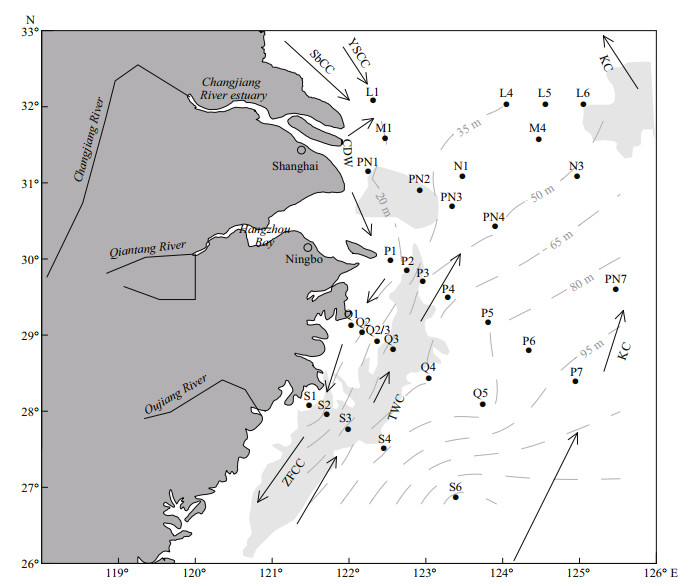
|
| Fig.1 Monitoring sites, various input rivers and major hydrodynamic flow patterns in the ECS Black dots represent the sampling stations. Shadow in light grey represents the mud areas. Dashed contours show the water depth in meter. Arrow indicates the spreading direction of currents including Yellow Sea Coastal Current (YSCC), Subei Coastal Current (SbCC), Changjiang Diluted Water (CDW), Zhejiang Fujian Coastal Current (ZFCC), Taiwan Warm Current (TWC), and Kuroshio Current (KC). |
Sediment grain size was measured after being treated by H2O2 (10%) and HCl (1 mol/L) for wet samples by a Laser Particle Size Analyzer (Cilas 940L) in the CAS Key Laboratory of Marine Geology and Environment, Institute of Oceanology, Chinese Academy of Sciences. After removing carbonate with HCl (1 mol/L) for dried samples, TOC and TN were determined by Elemental Analyzer (Thermo NE1112), and δ13C and δ15N were examined using a Thermo Finnigan Delta plus AD mass spectrometer in the Key Laboratory of Submarine Geosciences of Ministry of Natural Resources, with the precision of δ13C and δ15N of 0.2‰. TOC and TN were reported in weight percentage (%), and δ13C and δ15N in standard δ-notation as per mil (‰) relative to Vienna Pee Dee Belemnite (VPDB) standard and air, respectively. The temperature and salinity of water in each station were measured or calculated by a CTD profiler (SeaBird-911).
3 RESULT 3.1 HydrographyDistribution of SOM in the dynamic coastal margin is complicated under the complex hydrological and geological settings (Gordon and Goñi, 2003). The deposition, resuspension and remobilization of sediments induced by the coastal hydrodynamic conditions have great effects on the accumulation of SOM in the dynamic depositional environments (Hu et al., 2012). The river discharge and upwelling play key roles in the burial of SOM in the marginal seas as well (Deng et al., 2006). As the predominant source of runoff and terrestrial sediment to the ECS, the Changjiang River discharge ~5×108 t terrestrial particulate matter and 12×106 t OM annually (Wang et al., 2008).
The changes of riverine input, estuarine processes, currents, and shelf circulation reflected by the precise and detailed oceanographic and geochemical observation of temperature and salinity were exhibited in Fig. 2. Temperature varied within 9.51–20.6℃ (13.4℃ in average) in the surface water and decreased from the south to the north. The circulation of South Yellow Sea (SYS) contributed to the low temperature in the northeast. The high temperature in the south was ascribed to the incursion of Taiwan Warm Current (TWC) and Kuroshio Current (KC). The decrease of temperature in the bottom water (9.48–18.1℃, averaged 13.5℃) from the shore to the open sea suggested the dilution of riverine water to the seawater in the off-shore. In surface water, the salinity (26.3– 34.5, averaged 31.9) exhibited the bidirectional extension of Changjiang Diluted Water (CDW): one flowed toward north or northeast to the southwest of SYS and the other toward south or southeast to the ECS (Wang, 1998). Salinity in the bottom water ranged within 28.5–34.6 (averaged 32.9), with the high value reached as far as the coastal area owing to the incursion of KC.
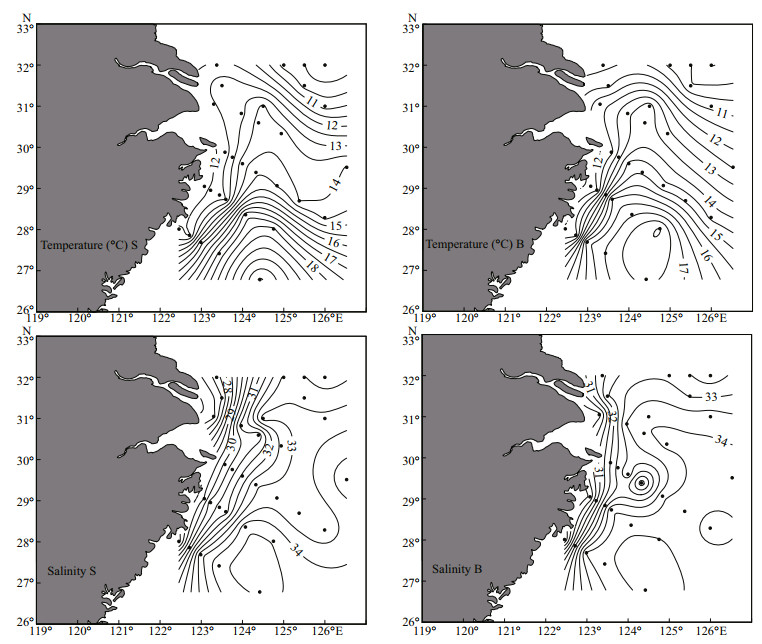
|
| Fig.2 Distribution of temperature and salinity in surface and bottom water of the ECS S: surface water; B: bottom water. |
The hydrodynamic forces influence the sediment sorting and accumulation of SOM in the coastal area (Hu et al., 2012). Sediment dispersal in our study was influenced by the circulation of the Yellow Sea Coastal Current (YSCC), the Subei Coastal Current (SbCC), the CDW, the Zhejiang Fujian Coastal Current (ZFCC), the TWC and the KC. The grain-size composition could characterize the source and transport of sediment to understand the fate of SOM (Sun et al., 2002), with the size <4 μm for clay, 4–63 μm for silt and >63 μm for sand. The percentages of clay, silt, and sand fraction varied within the range of 6.02%–43.7%, 14.8%–71.3%, and 0–76.7%, in average of 20.4%, 43.4%, and 36.2%, respectively. As displayed in Fig. 3, silt and clay predominated in the coast and coarser sediment dominated in the outer shelf. Categorized by the ternary diagram (Shepard, 1954), sediments in this study were mainly composed of clayey silt and silty sand, with only a few sites composed of sandy silt and sand (Fig. 4). The predominant of fine-grained sediment (clay+silt) formed the depositional mud areas in the inner shelf due to the delivery of SbCC from the old Huanghe (Yellow) River estuary to the northeast area and of ZFCC from the Changjiang River southward to the southern inner shelf.
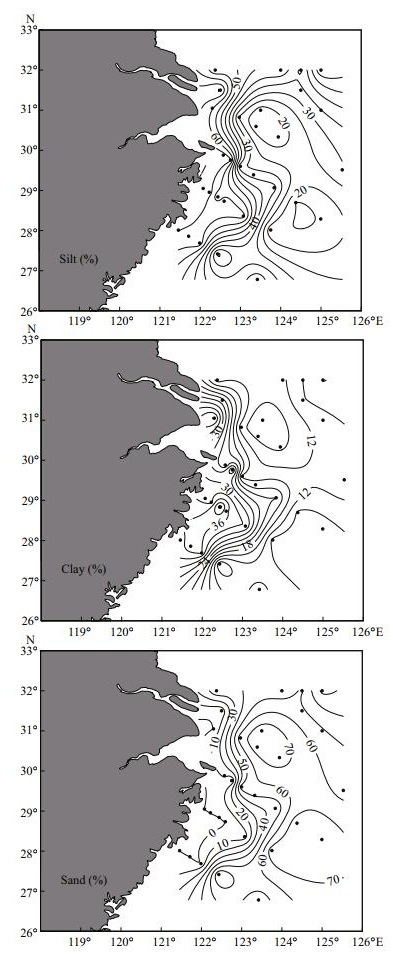
|
| Fig.3 Distribution of clay, silt and sand fractions in surface sediment of the ECS |
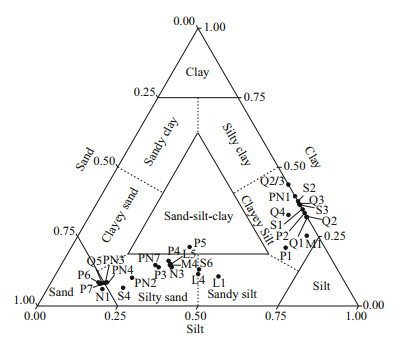
|
| Fig.4 Shepard triangular classification of surface sediment in the ECS |
Contents of TOC, TN and C/N ratios ranged within 0.14%–0.99%, 0.03%–0.15%, and 5.13–10.5 in surface sediment of the ECS, with the mean value of 0.52%, 0.08%, and 7.92, respectively. Values of δ13C in present study ranged from -22.71‰ to -20.26‰ (averaged of -21.43‰), which was close to that in the ECS Shelf (-22.08‰– -19.99‰, Zhou et al., 2018), the coastal area of the ECS (-22.7‰– -20.6‰, Zhang et al., 2017) and the Sishili Bay (-22.7‰– -21.6‰, Liu et al., 2012), but higher than that in the Changjiang River estuary (-29.8‰– -23.7‰, Liu et al., 2004) and the Zhujiang (Pearl) River estuary (-25.19‰– -23.33‰, Zhang et al., 2009). The δ15N values in the present study varied between 2.77‰ and 4.84‰ (averaged 3.84‰), which was lower than that in the ECS Shelf (3.67‰–6.28‰, Zhou et al., 2018), the Zhujiang River estuary (3.73‰–6.57‰, Zhang et al., 2009) and the Sishili Bay (5.4‰–6.5‰, Liu et al., 2012). The molar C/N ratio in this study fluctuated from 5.13 to 10.5, which was comparable to that in other riverdominated depositional regions around the world including the ECS Shelf (4.69–9.12, Zhou et al., 2018), the Bohai Bay (3.3–7.7, Hu et al., 2009), the Zhujiang River estuary (8.1–17.2, Zhang et al., 2009) and the Sishili Bay (7.9–10.1, Liu et al., 2012).
As Fig. 5 displayed, content of TOC (0.14%– 0.99%) increased southward and corresponded to the trend of fine-grained constituents, with the correlation coefficient of 0.92 to clay (P < 0.01), suggesting the potential influence of hydrodynamic forces on the accumulation of SOM and the sediment sorting in the coastal ECS. The TN concentration (0.03%–0.15%) was proportionally to the TOC (R2=0.943 2; P < 0.01), with the higher values occurred in the mud patches. Previous investigation also pointed out that the close relationship of SOM to the fine-grained sediments indicated the possible delivery from the inner shelf to the southern Okinawa Trough (Kao et al., 2003). In addition, it was reported that the TOC contents depleted in the maximum turbidity zone of the Changjiang River estuary where the burial of OC in sediment fraction of < 32 μm was relatively low (Shi et al., 2016).
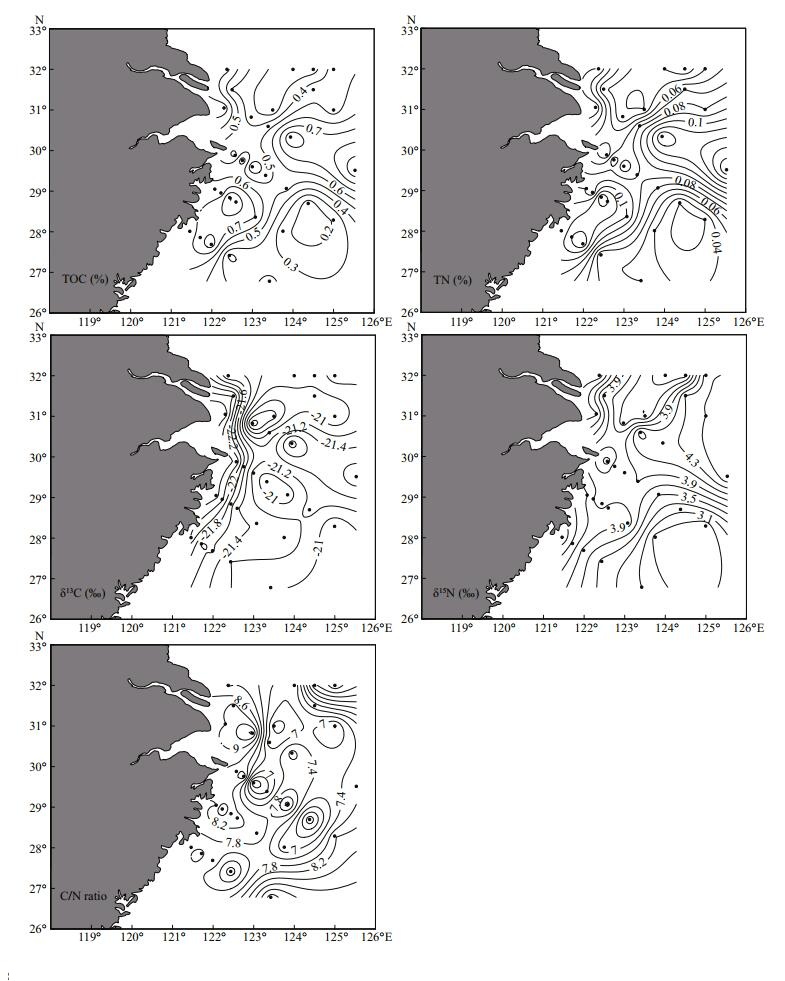
|
| Fig.5 Distribution of TOC, TN, δ13C, δ15N and C/N ratio in surface sediment of ECS |
The molar ratio of C/N was widely employed as a general proxy for OM sources, with the criteria 5–7 for the MOM (Redfield et al., 1963), >15 for the TOM (Meyers, 1997), 20–500 in the high plant tissues, 4–7 in the plankton organisms and 4.1–4.2 in the bacteria (Pereira et al., 1996; Hedges et al., 1997; Müller and Mathesius, 1999). The TOM from the Changjiang River was mainly from the soil with ratio of 10–15, and while the phytoplankton was the major source of MOM with ratio of 5–8 (Zhang et al., 2007). The C/N ratio in our study (5.13–10.5) indicated the predominant role of marine origin for SOM and the minor effect of debris of terrestrial plant on SOM in the ECS compared with the Redfield ratio 5.7 (wt/wt) of marine phytoplankton. The regression line between TOC and TN with the small negative intercept (Fig. 6) suggested that most of the nitrogen measured, probably in the organic form, was related to the SOM and the influence of the sorption of inorganic nitrogen on organic matter was negligible (Goñi et al., 2003). The higher value of the C/N ratios occurred in the Changjiang River estuary and inner shelf along ZFCC, with the decrease seaward suggested the enrichment of MOM and the relative depletion of TOM. In addition, the low C/N ratios are owing to the contribution of microorganism-derived and soilderived OM, which are widely observed in the coastal settings with significant anthropogenic inputs and intensified resuspension of fine-grained sediments (Hu et al., 2012). Therefore, hydrological forces have great effect on the elemental signature of SOM besides the act on the accumulation of SOM in this region.

|
| Fig.6 Scatter plot of TOC and TN in the surface sediment of ECS Solid line represents the regression line between TOC and TN in sediment samples; dashed line indicates the Redfield ratio of 5.7 (wt/wt). |
As the reliable proxy to distinguish the terrestrial and marine sources of SOM, the relative contribution of TOM and MOM in the marine sediment was traditionally estimated by the δ13C value, with -33‰– -22‰ (-27‰ in average), -16‰– -9‰ (-13‰ in average), -22‰– -18‰, -21‰– -19‰, and -27‰– -25‰ ranged for the terrigenous C3 plant, the terrigenous C4 plant (Pancost and Boot, 2004), the MOM (Cifuentes and Eldridge, 1998), the phytoplankton of the ECS and Changjiang River (Wu et al., 2003, 2007; Zhang et al., 2007), respectively. In this study, the bulk sediment δ13C (pre-aged with Δ14C =-305‰±102‰ for inner shelf of the ECS; Bao et al., 2016) is around -22.71‰– -20.26‰ (-21.43‰ in average), which is more depleted than, or approximate to the values of MOM. Values of δ13C in the present study were within the ones for the TOM from the Changjiang River and the phytoplankton from the ECS, indicating the mixture of terrestrial and marine sources for SOM. Further, the value is similar to that in the ECS continental shelf (-22.7‰– -20.1‰) (Xing et al., 2011), but higher than that for the suspended OM (-25.4‰– -19.7‰) in the Changjiang River estuary (Tan et al., 1991). As reported, the modern TOM discharged by the Changjiang River into the coastal ECS is mainly derived from the C3 land vascular higher plants (Hu et al., 2012). The depletion of δ13C in the estuary and the inner shelf along the Zhejiang-Fujian coast suggested the significant terrestrial input. Similar to the distribution pattern reported by the previous study (Hu et al., 2012), δ13C generally displayed a seaward increase, with the value as high as that in the phytoplankton of the ECS in the middle-outer shelf, reflecting the seaward increasing fraction of the MOM relative to the TOM. Therefore, the marine autogenic source was regarded as the predominant source of SOM in this study except the influence of the terrigenous input in the nearshore areas.
The change of δ15N during OM decomposition process limited the use as the single evidence to discriminate the provenance compared to the relatively stable of δ13C (Thornton and McManus, 1994; Ramaswamy et al., 2008; Gireeshkumar et al., 2013). Sedimentary δ15N has been thus used as the additional evidence to further constrain the SOM sources, with 3‰–12‰ for MOM and 8.6‰ for marine phytoplankton (Lamb et al., 2006), while -10‰–10‰ for TOM with an average of 2‰ (Dean et al., 1986). The δ15N of OM from nitrogen fixing land plant was around zero, whereas a positive value (0.4‰) for terrestrial C3 plant was found in plant only using mineral N from soil NOˉ3 or NH+4 (Ramaswamy et al., 2008). The δ15N in present study (2.77‰– 4.84‰, in average of 3.84‰) was within the range of the value in marine phytoplankton and TOM and comparable to the average value of marine nitrate (Sigman et al., 2000), suggesting the mixed contribution of terrestrial and marine sources of the SOM. The depletion of δ15N in the Hangzhou Bay and southern inner shelf reflected the dominant terrestrial input from the Changjiang River and the transport of the SOM by the coastal current from the estuary to the inner shelf along the ZFCC. The enriched δ15N in the Changjiang River estuary was ascribed to the incomplete utilization of nitrate in the river due to the light limitation in the turbid water. As reported, the δ15N was generally enriched in the oxic sediments at the sediment-water interface during sinking and residence in the early diagenesis (Altabet et al., 1999; Sachs et al., 1999).
4.2 Quantitative evaluation of OM sourcesTo evaluate the contribution of the TOM and the MOM in the ECS, C/N-δ13C and δ13C-δ15N in the surface sediment of the ECS, the particulate matter and the phytoplankton in the Changjiang River estuary as the terrestrial and marine end-members, respectively, were listed in Fig. 7. In dual plots, C/N, δ13C, and δ15N in the terrestrial sources were defined as 10–14, -27‰– -25‰, 3.5‰–6.5‰ and in the marine source as 5–8, -21‰– -19‰, 4.5‰–7.5‰ (Wu et al., 2007; Zhang et al., 2007). The scattered distribution of measured values between the terrestrial and marine sources confirmed the mixing of TOM and MOM for SOM of the ECS, with the values closer to marine sources, especially three stations completely falling into the ranges of marine source. The δ13C values with little TOM characteristic suggest the obvious addition of MOM even that the majority sediments are from the Changjiang River in the inner shelf.
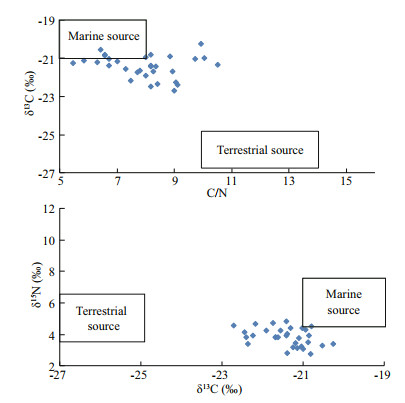
|
| Fig.7 Dual plots and potential sources of OM in the ECS based on C/N-δ13C and δ13C-δ15N compositions |
Considering δ13C as the source tracer, a two endmember mixing model was used to examine the relative importance of TOM and MOM to the SOM in the ECS based on the following equation (Westerhausen et al., 1993; Eadie et al., 1994):

where x and (1–x) represent the fraction for the terrestrial and marine end-member, respectively. Cmeasured, Cterrestrial, and Cmarine represent δ13C value in sample, TOM (-26‰) and MOM (-20‰) (Duan et al., 2017). Results showed that SOM of the ECS was a mixture of terrestrial and marine inputs with marine source as the dominance contributor. The contribution of TOM accounted for 4.3%–45.2% (23.9% on average) of the total OM and decreased seaward, with higher proportions found in the mud areas, especially in the Changjiang River estuary and the southern inner shelf as a consequence of the rapid burial of fluvial carbon (Fig. 8). The percentage of MOM ranged from 54.8% to 95.7% (76.1% on average), which was comparable to the estimation in the previous study (65.4%–100%; Zhou et al., 2018). The relative importance of MOM in the middle-outer shelf confirmed the predominant contribution of MOM. The dynamics of the overlying water can affect the OM provenance in the surface sediment. As Fig. 5 demonstrated, the pathway of open seawater to the northern part of ECS coincided with the obvious tongue-shaped with relatively low percentage of TOM and the intrusion of KC to the east of Changjiang River estuary detailed the influence of Kuroshio water on the distribution of OM (Wang and Oey, 2016). The OM from the marine phytoplankton could be partly decomposed in the surface sediment, but it will increase owing to the higher accumulation rate than the decomposition rate in high sedimentation environment (Andrieux and Aminot, 1997; Rabouille et al., 2008).
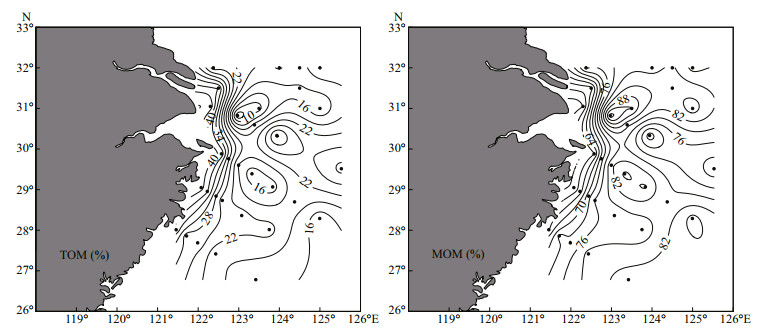
|
| Fig.8 Distribution of the contribution of TOM and MOM in the ECS |
The burial flux (BF, mg/(cm2∙a)) of the organic components in the surface sediments of the ECS was calculated by the following formula (Fang et al., 2015; Wang et al., 2017):

where CTOC is the measured content of sedimentary TOC(%), ρ, ω, and φ represent the dry density of the sediment samples (g/cm3), the sedimentation rate (cm/a), and the sediment porosity (dimensionless), respectively. The value of the porosity (φ) was denoted as 0.75, the median within the range of 0.7– 0.8 measured in the sediment mixing layers around the world (Ali et al., 2014). Value of 1.2 g/cm3 was used for ρ (Liu et al., 2007). The spatial distribution of ω (Fig. 9) was obtained by the Kriging interpolation method based on the accurately dated values collected in previous studies (DeMaster et al., 1985; Alexander et al., 1991; Chung and Chang, 1995; Huh and Su, 1999; Xia et al., 1999, 2004; Wu et al., 2001; Oguri et al., 2003; Guo et al., 2006; Lim et al., 2007; Wei et al., 2007; Yang and Chen, 2007; Duan et al., 2013; Fan et al., 2014).
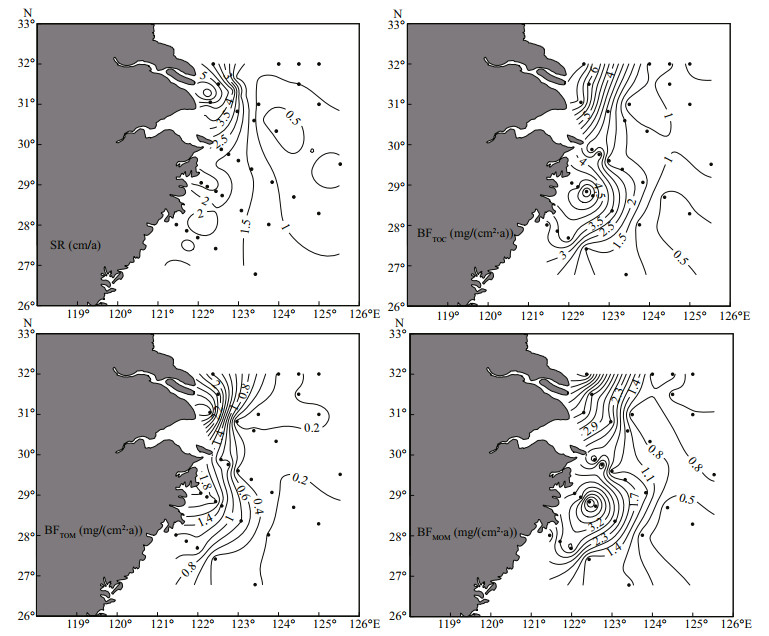
|
| Fig.9 Distribution of sedimentation rate and the burial flux of TOC, TOM, and MOM in the ECS |
The burial flux of OC in the ECS varied from 0.34 mg/(cm2∙a) to 7.56 mg/(cm2∙a) and averaged 2.80 mg/(cm2∙a), with obvious spatial heterogeneity (Fig. 9). The higher burial fluxes were found in the estuary and the inner shelf and it decreased seaward with the increasing distance from the shore due to the significant input of the land-based sources, as the distribution of the sedimentation rates clearly evidenced (Fig. 9). Similar to the variation of the TOC content, high burial flux was observed in the finegrained mud areas as well, manifesting the effect of shelf mud depositional process on the fate of SOM. The terrestrial sediment mainly deposited in the Changjiang River estuary, and the Zhejiang-Fujian coast and the mud region. Considering the quantitative contributions of MOM (76.1% on average) and TOM (23.9% on average) to the SOM, the burial fluxes of terrestrial and marine OC estimated in our study ranged 0.27–5.78 mg/(cm2∙a) (2.01 mg/(cm2∙a) on average) and 0.05–3.13 mg/(cm2∙a) (0.79 mg/(cm2∙a) on average), respectively. The sharp decrease of the burial flux of OC from the inner to the outer shelf indicated that the majority of the sedimentary OC were deposited in the inner shelf, with only a minor fraction moving eastwards.
5 CONCLUSIONThe mixed origins, hydrodynamic condition, and depositional processes of the fine-grained sediment affect the accumulation and the transport of the SOM from the inner shelf to the open sea. The relationship between TOC and TN suggested their co-variation during the investigation period and the affinity of nitrogen measured to SOM. The enrichment of δ13C and depletion of C/N and δ15N seaward illustrated the increase of MOM and the relative decrease of TOM. Moreover, the presence of microorganism-derived OM and anthropogenic inputs could also be responsible for the low C/N ratios and enriched δ13C in the coastal region. Terrestrial plant debris played a minor role in the SOM based on the close of average C/N ratio to the Redfield ratio of marine phytoplankton. The two end-member mixing model evaluated quantitatively the contribution for the SOM with 54.8%–95.7% (averaged 76.1%) of the MOM and 4.3%–45.2% (averaged 23.9%) of the TOM. The enrichment of the burial flux of OC in the fine-grained mud areas manifested the effect of shelf mud depositional process on the fate of SOM and the depletion seaward further indicated the significant input of the land-based sources. The sharp decrease of the burial fluxes of terrestrial and marine OC toward sea confirmed the majority of organic carbon were settled in the inner shelf and only a minor portion were further transported eastwards.
6 DATA AVAILABILITY STATEMENTThe data that support the findings of this study are available from the corresponding author upon reasonable request.
Alexander C R, DeMaster D J, Nittrouer C A. 1991. Sediment accumulation in a modern epicontinental-shelf setting:the Yellow Sea. Marine Geology, 98(1): 51-72.
DOI:10.1016/0025-3227(91)90035-3 |
Ali U, Syed J H, Liu J W, Sánchez-García L, Malik R N, Chaudhry M J I, Arshad M, Li J, Zhang G, Jones K C. 2014. Assessing the relationship and influence of black carbon on distribution status of organochlorines in the coastal sediments from Pakistan. Environmental Pollution, 190: 82-90.
DOI:10.1016/j.envpol.2014.03.024 |
Altabet M A, Pilskaln C, Thunell R, Pride C, Sigman D, Chavez F, Francois R. 1999. The nitrogen isotope biogeochemistry of sinking particles from the margin of the Eastern North Pacific. Deep Sea Research Part I:Oceanographic Research Papers, 46(4): 655-679.
DOI:10.1016/S0967-0637(98)00084-3 |
Andrieux F, Aminot A. 1997. A two-year survey of phosphorus speciation in the sediments of the Bay of Seine (France). Continental Shelf Research, 17(10): 1 229--1 245.
DOI:10.1016/S0278-4343(97)00008-3 |
Bao R, McIntyre C, Zhao M X, Zhu C, Kao S J, Eglinton T I. 2016. Widespread dispersal and aging of organic carbon in shallow marginal seas. Geology, 44(10): 791-794.
DOI:10.1130/G37948.1 |
Belicka L L, Macdonald R W, Harvey H R. 2002. Sources and transport of organic carbon to shelf, slope, and basin surface sediments of the Arctic Ocean. Deep Sea Research Part I:Oceanographic Research Papers, 49(8): 1 463-1 483.
DOI:10.1016/S0967-0637(02)00031-6 |
Berner R A. 1982. Burial of organic carbon and pyrite sulfur in the modern ocean:its geochemical and environmental significance. American Journal of Science, 282(4): 451-473.
DOI:10.2475/ajs.282.4.451 |
Bianchi T S, Allison M A. 2009. Large-river delta-front estuaries as natural "recorders" of global environmental change. Proceedings of the National Academy of Sciences of the United States of America, 106(20): 8 085-8 092.
DOI:10.1073/pnas.0812878106 |
Blair N E, Aller R C. 2012. The fate of terrestrial organic carbon in the marine environment. Annual Review of Marine Science, 4: 401-423.
DOI:10.1146/annurev-marine-120709-142717 |
Carreira R S, Cordeiro L G M S, Bernardes M C, Hatje V. 2016. Distribution and characterization of organic matter using lipid biomarkers:a case study in a pristine tropical bay in NE Brazil. Estuarine, Coastal and Shelf Science, 168: 1-9.
DOI:10.1016/j.ecss.2015.11.007 |
Chung Y, Chang W C. 1995. Pb-210 fluxes and sedimentation rates on the lower continental slope between Taiwan and the South Okinawa Trough. Continental Shelf Research, 15(2-3): 149-164.
DOI:10.1016/0278-4343(94)E0023-F |
Cifuentes L A, Eldridge P M. 1998. A mass-and isotopebalance model of DOC mixing in estuaries. Limnology and Oceanography, 43(8): 1 872-1 882.
DOI:10.4319/lo.1998.43.8.1872 |
Dean W E, Arthur M A, Claypool G E. 1986. Depletion of 13C in Cretaceous marine organic matter:source, diagenetic, or environmental sigal?. Marine Geology, 70(1-2): 119-157.
DOI:10.1016/0025-3227(86)90092-7 |
DeMaster D J, McKee B A, Nittrouer C A, Qian J C, Cheng G D. 1985. Rates of sediment accumulation and particle reworking based on radiochemical measurements from continental shelf deposits in the East China Sea. Continental Shelf Research, 4(1-2): 143-158.
DOI:10.1016/0278-4343(85)90026-3 |
Deng B, Zhang J, Wu Y. 2006. Recent sediment accumulation and carbon burial in the East China Sea. Global Biogeochemical Cycles, 20(3).
DOI:10.1029/2005GB002559 |
Duan L Q, Song J M, Yuan H M, Li X G, Li N, Peng Q C. 2017. The use of sterols combined with isotope analyses as a tool to identify the origin of organic matter in the East China Sea. Ecological Indicators, 83: 144-157.
DOI:10.1016/j.ecolind.2017.07.042 |
Duan L Q, Song J M, Yuan H M, Li X G, Li N. 2013. Spatiotemporal distribution and environmental risk of arsenic in sediments of the East China Sea. Chemical Geology, 340: 21-31.
DOI:10.1016/j.chemgeo.2012.12.009 |
Eadie B J, McKee B A, Lansing M B, Robbins J A, Metz S, Trefry J H. 1994. Records of nutrient-enhanced coastal ocean productivity in sediments from the Louisiana continental shelf. Estuaries, 17(4): 754-765.
DOI:10.2307/1352745 |
Fan Y, Huh C A, Lan J, Zhao M X, Zhao Z S, Li G L, Sun J T, Jiang G B. 2014. Major sources of MeO/OH-BDEs in the East China Sea elucidated from their records and phytoplankton biomarkers. Environmental Pollution, 192: 1-8.
DOI:10.1016/j.envpol.2014.04.037 |
Fang Y, Chen Y J, Ti an, C G, Lin T, Hu L M, Huang G P, Tang J H, Li J, Zhang G. 2015. Flux and budget of BC in the continental shelf seas adjacent to Chinese high BC emission source regions. Global Biogeochemical Cycles, 29(7): 957-972.
DOI:10.1002/2014GB004985 |
Gireeshkumar T R, Deepulal P M, Chandramohanakumar N. 2013. Distribution and sources of sedimentary organic matter in a tropical estuary, south west coast of India(Cochin estuary):a baseline study. Marine Pollution Bulletin, 66(1-2): 239-245.
DOI:10.1016/j.marpolbul.2012.10.002 |
Goñi M A, Teixeira M J, Perkey D W. 2003. Sources and distribution of organic matter in a river-dominated estuary(Winyah Bay, SC, USA). Estuarine, Coastal and Shelf Science, 57(5-6): 1 023-1 048.
DOI:10.1016/S0272-7714(03)00008-8 |
Gordon E S, Goñi M A. 2003. Sources and distribution of terrigenous organic matter delivered by the Atchafalaya River to sediments in the northern Gulf of Mexico. Geochimica et Cosmochimica Acta, 67(13): 2 359-2 375.
DOI:10.1016/S0016-7037(02)01412-6 |
Guo Z G, Lin T, Zhang G, Yang Z S, Fang M. 2006. Highresolution depositional records of polycyclic aromatic hydrocarbons in the central continental shelf mud of the East China Sea. Environmental Science & Technology, 40(17): 5 304-5 311.
DOI:10.1021/es060878b |
Hedges J I, Keil R G, Benner R. 1997. What happens to terrestrial organic matter in the ocean?. Organic Geochemistry, 27(5-6): 195-212.
DOI:10.1016/S0146-6380(97)00066-1 |
Hu B Q, Li J, Zhao J T, Wei H L, Yin X J, Li G G, Liu G G, Liu Y, Sun Z L, Zou L, Bai F L, Dou Y G, Wang L B, Sun R T. 2014. Late Holocene elemental and isotopic carbon and nitrogen records from the East China Sea inner shelf:implications for monsoon and upwelling. Marine Chemistry, 162: 60-70.
DOI:10.1016/j.marchem.2014.03.008 |
Hu L M, Guo Z G, Feng J L, Yang Z S, Fang M. 2009. Distributions and sources of bulk organic matter and aliphatic hydrocarbons in surface sediments of the Bohai Sea, China. Marine Chemistry, 113(3-4): 197-211.
DOI:10.1016/j.marchem.2009.02.001 |
Hu L M, Shi X F, Yu Z G, Lin T, Wang H J, Ma D Y, Guo Z G, Yang Z S. 2012. Distribution of sedimentary organic matter in estuarine-inner shelf regions of the East China Sea:implications for hydrodynamic forces and anthropogenic impact. Marine Chemistry, 142-144: 29-40.
DOI:10.1016/j.marchem.2012.08.004 |
Huh C A, Su C C. 1999. Sedimentation dynamics in the East China Sea elucidated from 210Pb, 137Cs and 239, 240Pu. Marine Geology, 160(1-2): 183-196.
DOI:10.1016/S0025-3227(99)00020-1 |
Kao S J, Lin F J, Liu K K. 2003. Organic carbon and nitrogen contents and their isotopic compositions in surficial sediments from the East China Sea shelf and the southern Okinawa Trough. Deep Sea Research Part II:Topical Studies in Oceanography, 50(6-7): 1 203-1 21.
DOI:10.1016/S0967-0645(03)00018-3 |
Kubo A, Kanda J. 2017. Seasonal variations and sources of sedimentary organic carbon in Tokyo Bay. Marine Pollution Bulletin, 114(2): 637-643.
DOI:10.1016/j.marpolbul.2016.10.030 |
Kumar K S S, Nair S M, Salas P M, Cheriyan E. 2017. Distribution and sources of sedimentary organic matter in Chitrapuzha, a tropical tidal river, southwest coast of India. Environmental Forensics, 18(2): 135-146.
DOI:10.1080/15275922.2017.1304468 |
Lamb A L, Wilson G P, Leng M J. 2006. A review of coastal palaeoclimate and relative sea-level reconstructions using δ13C and C/N ratios in organic material. Earth-Science Reviews, 75(1-4): 29-57.
DOI:10.1016/j.earscirev.2005.10.003 |
Li D, Yao P, Bianchi T S, Zhang T T, Zhao B, Pan H H, Wang J P, Yu Z G. 2014. Organic carbon cycling in sediments of the Changjiang Estuary and adjacent shelf:implication for the influence of Three Gorges Dam. Journal of Marine Systems, 139: 409-419.
DOI:10.1016/j.jmarsys.2014.08.009 |
Li X X, Bianchi T S, Allison M A, Chapman P, Mitra S, Zhang Z R, Yang G P, Yu Z G. 2012. Composition, abundance and age of total organic carbon in surface sediments from the inner shelf of the East China Sea. Marine Chemistry, 145-147: 37-52.
DOI:10.1016/j.marchem.2012.10.001 |
Lim D I, Choi J Y, Jung H S, Rho K C, Ahn K S. 2007. Recent sediment accumulation and origin of shelf mud deposits in the Yellow and East China Seas. Progress in Oceanography, 73(2): 145-159.
DOI:10.1016/j.pocean.2007.02.004 |
Liu D Y, Shen X H, Wang Y J, Chen Y J, Li L. 2012. Tracking the sources of organic matter in the surface sediments of Sishili Bay, northern Yellow Sea and the environmental implication. Acta Oceanologica Sinica, 34(5): 205-212.
(in Chinese with English abstract) |
Liu J P, Xu K H, Li A C, Li A C, Milliman J D, Velozzi D M, Xiao S B, Yang Z S. 2007. Flux and fate of Yangtze River sediment delivered to the East China Sea. Geomorphology, 85(3-4): 208-224.
DOI:10.1016/j.geomorph.2006.03.023 |
Liu M, Hou L J, Xu S Y, Ou D N, Jiang H Y, Yu J, Gardner W S. 2004. Carbon and nitrogen stable isotopes as tracers to source organic matter in the Yangtze Estuary. Acta Geographica Sinica, 59(6): 918-926.
(in Chinese with English abstract) |
Meyers P A. 1997. Organic geochemical proxies of paleoceanographic, paleolimnologic, and paleoclimatic processes. Organic Geochemistry, 27(5-6): 213-250.
DOI:10.1016/S0146-6380(97)00049-1 |
Milliman J D, Syvitski J P M. 1992. Geomorphic/tectonic control of sediment discharge to the ocean:the importance of small mountainous rivers. The Journal of Geology, 100(5): 525-544.
DOI:10.1086/629606 |
Müller A, Mathesius U. 1999. The palaeoenvironments of coastal lagoons in the southern Baltic Sea, I. The application of sedimentary Corg/N ratios as source indicators of organic matter. Palaeogeography, Palaeoclimatology, Palaeoecology, 145(1-3): 1-16.
DOI:10.1016/S0031-0182(98)00094-7 |
Oguri K, Matsumoto E, Yamada M, Saito Y, Iseki K. 2003. Sediment accumulation rates and budgets of depositing particles of the East China Sea. Deep Sea Research Part II:Topical Studies in Oceanography, 50(2): 513-528.
DOI:10.1016/S0967-0645(02)00465-4 |
O'Reilly S S, Szpak M T, Flanagan P V, Monteys X, Murphy B T, Jordan S F, Allen C C R, Simpson A J, Mulligan S M, Sandron S, Kelleher B P. 2014. Biomarkers reveal the effects of hydrography on the sources and fate of marine and terrestrial organic matter in the western Irish Sea. Estuarine, Coastal and Shelf Science, 136: 157-171.
DOI:10.1016/j.ecss.2013.11.002 |
Pancost R D, Boot C S. 2004. The palaeoclimatic utility of terrestrial biomarkers in marine sediments. Marine Chemistry, 92(1-4): 239-261.
DOI:10.1016/j.marchem.2004.06.029 |
Pereira W E, Hostettler F D, Rapp J B. 1996. Distributions and fate of chlorinated pesticides, biomarkers and polycyclic aromatic hydrocarbons in sediments along a contamination gradient from a point-source in San Francisco Bay, California. Marine Environmental Research, 41(3): 299-314.
DOI:10.1016/0141-1136(95)00021-6 |
Rabouille C, Conley D J, Dai M H, Cai W J, Chen C T A, Lansard B, Green R, Yin K, Harrison P J, Dagg M, McKee B. 2008. Comparison of hypoxia among four riverdominated ocean margins:the Changjiang (Yangtze), Mississippi, Pearl, and Rhône rivers. Continental Shelf Research, 28(12): 1 527-1 537.
DOI:10.1016/j.csr.2008.01.020 |
Ramaswamy V, Gaye B, Shirodkar P V, Rao P S, Chivas A R, Wheeler D, Thwin S. 2008. Distribution and sources of organic carbon, nitrogen and their isotopic signatures in sediments from the Ayeyarwady (Irrawaddy) continental shelf, northern Andaman Sea. Marine Chemistry, 111(3-4): 137-150.
DOI:10.1016/j.marchem.2008.04.006 |
Redfield A C, Ketchum B H, Richards F A. 1963. The influence of organisms on the composition of sea-water. In:Hill M N ed. The Composition of Seawater:Comparative and Descriptive Oceanography. The Sea:Ideas and Observations on Progress in the Study of the Seas. WileyInterscience, New York. p.26-77.
|
Sachs J P, Repeta D J, Goericke R. 1999. Nitrogen and carbon isotopic ratios of chlorophyll from marine phytoplankton. Geochimica et Cosmochimica Acta, 63(9): 1 431-1 441.
DOI:10.1016/S0016-7037(99)00097-6 |
Shepard F P. 1954. Nomenclature based on sand-silt-clay ratios. Journal of Sedimentary Research, 24(3): 151-158.
DOI:10.1306/D4269774-2B26-11D7-8648000102C1865D |
Shi X F, Hu L M, Qiao S Q, Bai Y Z. 2016. Progress in research of sedimentary organic carbon in the East China Sea:sources, dispersal and sequestration. Advances in Marine Science, 34(3): 313-327.
(in Chinese with English abstract) |
Sigman D M, Altabet M A, McCorkle D C, Francois R, Fischer G. 2000. The δ15N of nitrate in the southern Ocean:nitrogen cycling and circulation in the ocean interior. Journal of Geophysical Research:Oceans, 105(C8): 19 599-19 614.
DOI:10.1029/2000JC000265 |
Suk B C. 1989. Sedimentology and history of sea level changes in the East China Sea and adjacent seas. In:Taira A, Masuda F eds. Sedimentary Facies in the Active Plate Margin. Terra Scientific Publishing, Tokyo. p.215-231.
|
Sun D H, Bloemendal J, Rea D K, Vandenberghe J, Jiang F C, An Z S, Su R X. 2002. Grain-size distribution function of polymodal sediments in hydraulic and aeolian environments, and numerical partitioning of the sedimentary components. Sedimentary Geology, 152(3-4): 263-277.
DOI:10.1016/S0037-0738(02)00082-9 |
Tan F C, Cai D L, Edmond J M. 1991. Carbon isotope geochemistry of the Changjiang estuary. Estuarine, Coastal and Shelf Science, 32(4): 395-403.
DOI:10.1016/0272-7714(91)90051-C |
Thornton S F, McManus J. 1994. Application of organic carbon and nitrogen stable isotope and C/N ratios as source indicators of organic matter provenance in estuarine systems:evidence from the Tay Estuary, Scotland. Estuarine, Coastal and Shelf Science, 38(3): 219-233.
DOI:10.1006/ecss.1994.1015 |
Voβ M, Struck U. 1997. Stable nitrogen and carbon isotopes as indicator of eutrophication of the Oder river (Baltic sea). Marine Chemistry, 59(1-2): 35-49.
DOI:10.1016/S0304-4203(97)00073-X |
Wang B D. 1998. On the extension and nutrient transportation of the Changjiang River diluted water. Journal of Oceanography of Huanghai & Bohai Seas, 16(2): 41-47.
(in Chinese with English abstract) |
Wang C L, Zou X Q, Zhao Y F, Li Y L, Song Q C, Wang T, Yu W W. 2017. Distribution pattern and mass budget of sedimentary polycyclic aromatic hydrocarbons in shelf areas of the eastern china marginal seas. Journal of Geophysical Research:Oceans, 122(6): 4 990-5 004.
DOI:10.1002/2017JC012890 |
Wang J, Oey L Y. 2016. Seasonal exchanges of the Kuroshio and shelf waters and their impacts on the shelf currents of the East China Sea. Journal of Physical Oceanography, 46(5): 1 615-1 632.
DOI:10.1175/JPO-D-15-0183.1 |
Wang X C, Sun M Y, Li A C. 2008. Contrasting chemical and isotopic compositions of organic matter in Changjiang(Yangtze River) estuarine and East China Sea shelf sediments. Journal of Oceanography, 64(2): 311-321.
DOI:10.1007/s10872-008-0025-1 |
Wei T Y, Chen Z Y, Duan L Y, Gu J W, Saito Y, Zhang W G, Wang Y H, Kanai Y. 2007. Sedimentation rates in relation to sedimentary processes of the Yangtze Estuary, China. Estuarine, Coastal and Shelf Science, 71(1-2): 37-46.
DOI:10.1016/j.ecss.2006.08.014 |
Westerhausen L, Poynter J, Eglinton G, Erlenkeuser H, Sarnthein M. 1993. Marine and terrigenous origin of organic matter in modern sediments of the equatorial East Atlantic:the σ13C and molecular record. Deep Sea Research Part I:Oceanographic Research Papers, 40(5): 1 087-1 121.
DOI:10.1016/0967-0637(93)90091-G |
Wong G T F, Chao S Y, Li Y H, Shiah F K. 2000. The Kuroshio edge exchange processes (KEEP) study-an introduction to hypotheses and highlights. Continental Shelf Research, 20(4-5): 335-347.
DOI:10.1016/S0278-4343(99)00075-8 |
Wu Y, Zhang J, Li D J, Wei H, Lu R X. 2003. Isotope variability of particulate organic matter at the PN section in the East China Sea. Biogeochemistry, 65(1): 31-49.
DOI:10.1023/A:1026044324643 |
Wu Y, Zhang J, Liu S M, Zhang Z F, Yao Q Z, Hong G H, Cooper L. 2007. Sources and distribution of carbon within the Yangtze River system. Estuarine, Coastal and Shelf Science, 71(1-2): 13-25.
DOI:10.1016/j.ecss.2006.08.016 |
Wu Y, Zhang J, Mi T Z, Li B. 2001. Occurrence of n-alkanes and polycyclic aromatic hydrocarbons in the core sediments of the Yellow Sea. Marine Chemistry, 76(1-2): 1-15.
DOI:10.1016/S0304-4203(01)00040-8 |
Xia X M, Xie Q C, Li Y, Li B G, Feng Y J. 1999. 137Cs and 210Pb profiles of the seabed cores along the East China Sea coast and their implications to sedimentary environment. Donghai Marine Science, 17(1): 20-27.
(in Chinese with English abstract) |
Xia X M, Yang H, Li Y, Li B G, Pan S M. 2004. Modern sedimentation rates in the contiguous sea area of Changjiang Estuary and Hangzhou Bay. Acta Sedimentologica Sinica, 22(1): 130-135.
(in Chinese with English abstract) |
Xing L, Zhang H L, Yuan Z N, Sun Y, Zhao M X. 2011. Terrestrial and marine biomarker estimates of organic matter sources and distributions in surface sediments from the East China Sea shelf. Continental Shelf Research, 31(10): 1 106-1 115.
DOI:10.1016/j.csr.2011.04.003 |
Yang Z S, Chen X H. 2007. Centurial high resolution records of sediment grain-size variation in the mud area off the Changjiang (Yangtze River) Estuary and its influencial factors. Quaternary Sciences, 27(5): 690-699.
(in Chinese with English abstract) |
Yu J, Zhang H. 2017. Source apportionment of sediment organic material in a semi-enclosed sea using Bayesian isotopic mixing model. Marine Pollution Bulletin, 119(1): 365-371.
DOI:10.1016/j.marpolbul.2017.04.037 |
Zhang H L, Xing L, Zhao M X. 2017. Origins of terrestrial organic matter in surface sediments of the East China Sea shelf. Journal of Ocean University of China, 16(5): 793-802.
DOI:10.1007/s11802-017-3216-9 |
Zhang J, Wu Y, Jennerjahn T C, Ittekkot V, He Q. 2007. Distribution of organic matter in the Changjiang (Yangtze River) Estuary and their stable carbon and nitrogen isotopic ratios:implications for source discrimination and sedimentary dynamics. Marine Chemistry, 106(1-2): 111-126.
DOI:10.1016/j.marchem.2007.02.003 |
Zhang L, Yin K D, Wang L, Chen F R, Zhang D R, Yang Y Q. 2009. The sources and accumulation rate of sedimentary organic matter in the Pearl River Estuary and adjacent coastal area, Southern China. Estuarine, Coastal and Shelf Science, 85(2): 190-196.
DOI:10.1016/j.ecss.2009.07.035 |
Zhang S Y, Li S L, Dong H P, Zhao Q F, Lu X C, Shi J A. 2014. An analysis of organic matter sources for surface sediments in the central South Yellow Sea, China:evidence based on macroelements and n-alkanes. Marine Pollution Bulletin, 88(1-2): 389-397.
DOI:10.1016/j.marpolbul.2014.07.064 |
Zhou F X, Gao X L, Yuan H M, Song J M, Chen F J. 2018. The distribution and seasonal variations of sedimentary organic matter in the East China Sea shelf. Marine Pollution Bulletin, 129(1): 163-171.
DOI:10.1016/j.marpolbul.2018.02.009 |
Zhu C, Wang Z H, Xue B, Yu P S, Pan J M, Wagner T, Pancost R D. 2011. Characterizing the depositional settings for sedimentary organic matter distributions in the Lower Yangtze River-East China Sea Shelf System. Estuarine, Coastal and Shelf Science, 93(3): 182-191.
DOI:10.1016/j.ecss.2010.08.001 |
 2020, Vol. 38
2020, Vol. 38


